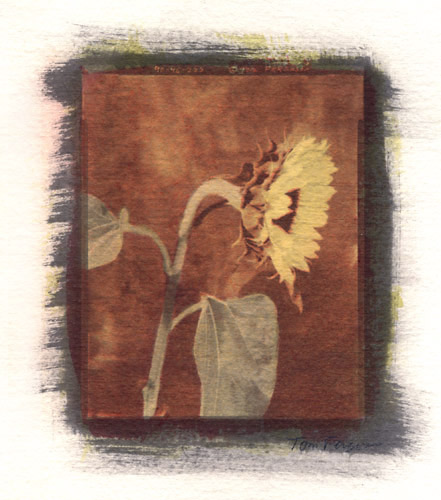
Alternative Process Tutorial #13
Printing Time without Test Strips

Illustration #107: Gum Print
Copyright © 1994 by Tom Ferguson
Click on image for larger view

Illustration #108: Cyan and Silver prints
Copyright © 1991 by Tom Ferguson
Click on image for larger view
Silver gelatin printers take exposure test strips for granted. A 50¢ piece of photo paper, 45 seconds to expose it, a few minutes in chemicals, and a silver gelatin exposure test strip is finished . Before an alternative processes photographer can create an exposure test strip he/she has to first mix the chemicals, then coat and dry the paper, then exposure and processing for quite long periods of time.
There is a better way. If you've done the tests in this series, you know your alternative process EI, and the step wedge value of your zone 2 negative (tutorial #9), and your personal MBT (for a given process, tutorial #11). Your zone 2 step wedge value is the key.
For these examples, assume your zone 2 negative matches step wedge value #4, and that your MBT is 6 minutes. Place the negative you want to print on your light source, and measure the area you want to print as zone 2 (very dark with a touch of detail). Find the step wedge value that matches your negative. If this value matches your zone 2 value (step wedge value #4 in our example), then your MBT is your correct printing exposure (6 minutes in this example). If the negative value is thinner than your zone 2 value, you need a shorter printing time. If your negative value is denser than your zone 2 value, you need a longer printing time.
Each section of the step wedge is 1/3 stop denser than the section below it. If the zone 2 area of the negative you want to print matches step table value #3, then your negative is 1/3 stop underexposed. An underexposed negative needs a shorter exposure to keep it from going dark. This negative needs 1/3 stop less print exposure than your MBT. These values are based on the square root of two. Ugh, advanced math! Ignore the advanced math, and hang illustration #109 and #110 in your darkroom. I have them hanging in mine. Looking up "exposure error minus 1 step" in illustration #110, you'll find 0.80 as your multiplier. You multiply your MBT by this factor to get this negative's correct printing time. In this case 4-3/4 minutes (6 times 0.8 equals 4.8).
Another example: the area on your negative you wish to print as zone 2 matches the step wedge value between 6. This is 2 steps denser than your zone 2 reference. Looking up "exposure error plus 2 steps" in illustration #109, you find 1.6 as your multiplier. Multiply our MBT by this factor to get this negative's correct printing time. In this case 9-1/2 minutes (6 times 1.6 equals 9.6).
What happens if you don't have an area you want to print as zone 2? Most images have an area of zone 3. Measure this area, find the step wedge value that matches it, then do your calculations using the step wedge value directly below your match. For this example, assume the area you want to print as zone 3 matches step table wedge #6. Use the step wedge value directly below #6, which is step wedge value #5, for your calculations. Your zone 2 reference is step table value #4, so your negative is 1 step overexposed. Looking up "exposure error plus 1 step" in table illustration #109 we find 1.3 as our multiplier. Our correct printing exposure is 7-3/4 minutes (6 times 1.3 equals 7.8).
EXPOSURE COMPENSATION Plus 6 steps (2 stops) X4.0 |
EXPOSURE COMPENSATION Minus 6 steps (2 stops) X0.25 |
| Illustration #109: Over Exposure Compensation |
Illustration #110: Under Exposure Compensation |
Click the "next" link below and we will begin our look at selenium toning negatives.